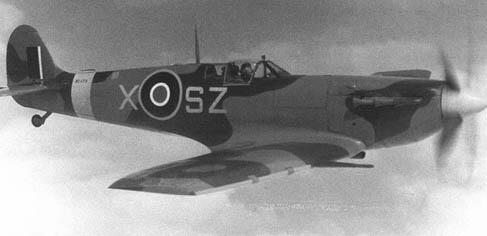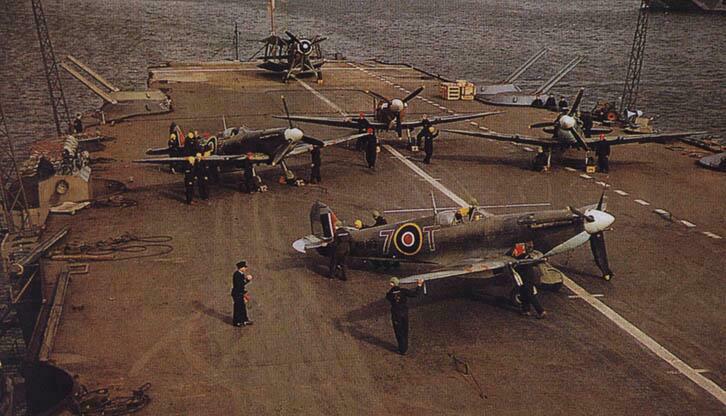BRITISH AVIATION RESOURCE CENTER > FIGHTERS > PREVIOUS PAGE

Spitfire Mk. VB 'LF'
|
Type: Single-seat fighter, fighter-bomber & Reconnaissance; Seafire: Carrier-Based fighter Origin: Supermarine Models: Spitfire: Mk. I to XXIV Seafire: Mk. I, III, XV, XVII and 45-47 First Flight: Prototype: March 5, 1936 Production Mk. I July 1938 Service Delivery: February 1936 Final Delivery (Mk. XXIV): October 1947 Number Produced: Spitfires: 20,334 Seafire: 2,556 See variants list for model breakdowns. Engine: Model: Rolls-Royce Merlin or Griffon (See variants) Type: 12-Cylinder liquid cooled Vee Number: One Horsepower: See Variants Dimensions: Wing span: Typical: 36 ft. 10 in. (11.23m) Clipped: 32 ft. 2 in. Clipped (More Common): 32 ft. 7 in. (9.93m) Extended: 40 ft. 2 in. (12.24m) Length: Early Models: 29 ft. 11 in. (9.12m) Later, 2-stage engine: 31 ft. 3.5 in. (9.54m) Griffon engine: 32 ft. 8 in. (9.96m) Final: 34 ft. 4 in. (10.46m) Height: Typical: 11 ft. 5 in. (3.48m) Griffon Engine: 12 ft. 9 in. (3.89m) Wing Surface Area: N/A |
Weights: Empty: Mk. I: 4,810 lb. (2182 kg) Mk. IX: 5,610 lb. (2545 kg) Mk. XIV: 6,700 lb. (3040 kg) Seafire 47: 7,625 lb. (3458 kg) Loaded: Mk. I: 5,784 lb. (2624 kg) Mk. IX: 9,500 lb. (4310 kg) Mk. XIV: 10,280 lb. (4663 kg) Seafire 47: 12,750 lb. (5784 kg) Performance: Maximum Speed: Mk. I: 355-362 mph (580 kph) Mk. IX: 408 mph (657 kph) Mk. XIV: 448 mph (721 kph) Seafire 47: 451 mph (724 kph) Initial Climb: Mk. I: 2,530 ft/min (770 m/min) Mk. IX: 4,100 ft/min (1250 m/min) Mk. XIV: 4,580 ft/min (1396 m/min) Seafire 47: 4,800 ft/min (1463 m/min) Service Ceiling: N/A Range (Internal Fuel): Mk. I: 395 miles (637 km) Mk. IX: 434 miles (700 km) Mk. XIV: 460 miles (740 km) Seafire 47: 405 miles (652 km) Armament: See Variants List |
Variants List: Main Types
|
Mk. I: Initial version, equipped with 1,030 hp Merlin II,
two-blade fixed-pitch propeller and four .303 in. Browning machine guns. Production: 450 Mk. IA: As I except eight .303 Brownings, bulged canopy, and three-blade DH v-p propeller. Production: N/A Mk. IB: As IA except two 20mm Hispano Cannon and four .303 in. Brownings. Production: 1,566 Mk. IIA: Mk. I built at Castle Bromwich with 1,175 hp Merlin XII and Rotol propeller, with eight .303 in. Brownings. Production: 750 Mk. IIB: As IIA, except two 20mm Hispano Cannon and four .303 in. Brownings. Production: 170 Mk. IV: First Griffon engined model. Details unavailable. Production: N/A PR.IV: Photo Reconnaisance version of Mk. IV, unarmed and equipped with 1,440hp Merlin 45.. Production: 229 Mk. V: Powered by 1,440hp Merlin 45. Many detail changes. Main fighter type from 1941-42. Equipped with centerline rack for 500 lb. (227 kg) bomb or tank. Many with clipped wings and/or tropical filter under nose. Built in three types: Mk. VA: Eight .303 in. Brownings in wings. Production: 94 Mk. VB: Two 20mm Hispano cannon and four .303 in. Brownings. Production: 3,923 Mk. VC: Universal wing with various gun configurations, additional racks for 250 lb. (113 kg.) bombs on wings. Production: 2,447 Mk. VI: Interim high altitude interceptor, 1,415 hp Merlin 47, pressurized cockpit, two 20mm Hispano Cannon and four .303 in. Brownings. Production: 100 Mk. VII: High altitude interceptor, extended wing-tips 1,660 hp Merlin 61 with two stage supercharger and symetrical underwing radiators, pressurized cockpit, retractable tail wheel, later broad and pointed rudder. Armament configuration: N/A Production: 140 Mk. VIII: Followed interim Mk. IX, virtually unpressurized Mk. VII in three forms: LF Low altitude, clipped wing, F Standard, and HF High Altitude, extended wing. Production (All Three forms): 1,658 Mk. IX: Hastily designed response to the Fw 190 created by fitting a Mk. V with 1,660 hp Merlin 61. Produced in LF, F, and HF versions plus IXE version with two 20mm Hispano cannon and two .5 in Brownings. Production (All four forms): 5,665 Mk. X: Pressurised photo reconnaisance, equipped with Merlin 77. Leading edge of wing formed into fuel tank. Production: 16 Mk. XI: As Mk. X but unpressurised. 1,760 Merlin 63A or 1,655 hp Merlin 70. Primary aircraft of Photo Reconnaisance Units 1943-1945. Production: 471 Mk. XII: Low altitude versions designed to deal with Fw 190 hit and run raiders. 1,735 hp Griffon III or IV. Strengthed Mk. VC airframe with clipped wings. Production: 100 Mk. XIII: Low-level reconnaissance, low-rated 1,620 hp Merlin 32, Four .303 in. Brownings. Production: 16 |
Mk. XIV: First model with two-stage Griffon, Mk. 65 rated at 2,050 hp with deep symetric
radiators and five-blade propeller. The airframe was completely redesigned and incorporated a
broad fin/rudder, inboard ailerons, retractable tail wheel. Active in 1944, destroyed over 300 V-1s. F.XIV: Two 20mm Hispano and four .303 brownings. F.XIVE: Two 20mm Hispano and two .5 in. brownings. FR.XIVE: Same guns as F.XIVE, cut-down fuselage and clipped wings, teardrop hood. F.24: Cameras and extra fuel. Production (all forms): 957 Mk. XVI: As Mk. IX except 1,705 hp Packard Merlin 266; LF.IXE, E-guns and clipped wings, many built with teardrop hood, extra fuel. Production: 1,054 Mk. XVIII: Definative wartime version fighter. Derived from interim XIV, extra fuel, stronger airframe, F and FR versions. Some FR versions with even more fuel and tropical equipment. Production: 300 Mk. XIX: Final photo-reconnaisance version. Unpressurised version with 2,050 hp Griffon 65, pressurised version with Griffon 66 and increased wing tankage. Both versions capable of handling deep slipper tanks for 1,800 mile (2900 km) range. Made last RAF Spitfire sortie over Malaya on April 1, 1954. Production: 225 Model 21: Post-war. Redesigned aircraft with different structure and shape. 2,050 hp Griffon 65 or 85, four 20mm cannon and rack for 1,000 lb. (454 kg) bombs. Production: 300 Model 22: Bubble hood, 24-volt electics. Some with 2,375 hp Griffon 65 with contrarotating prop. Production: 278 Model 24: Redesigned tail, short-barrel cannon, zero-length rocket launchers. Production: 54 Seafire IB: Navalised Spitfire VB, usually with 1,415 hp low-rated Merlin 46. Fixed wings but hook and slinging points. Conversions from Mk. VB: 266 Seafire IIC: Catapult spools, strengthened landing gear, 1,645 hp Merlin 32 and four-blade propeller. Various sub-types. Universal wing. Production: 262 by Supermarine, 110 by Westland. Seafire III: Manual double-fold wing, 1,585 hp Merlin 55M, various versions. Production: 870 by Westland, 350 by Cunliffe-Owen. Seafire XV (Late F.15): 1,850 hp Griffon VI, four-blade propeller. Asymmetric radiators. Cross between Seafire III and Spitfire XII. Production: 390 Seafire XVII (Late F.17): Increased fuel, cut-down fuselage and bubble hood. Production (curtailed by war's end): 232 Seafire 45: New aircraft based on Spitfire 21 with Griffon 61 (five-blade) or 85 (contrarotating props), fixed wing with four 20mm cannon. Production: 50 Seafire 46: Aircraft based on Spitfire 22. Production: 24 Seafire 47: Navalized Spitfire 24. Hydraulically folding wings, carb-air intake just behind propeller, increased fuel. Fought in Malaya and Korea.. Production: 140 |
|
Comments: Probably the most famous British fighter in history, the Spitfire is rivalled only by the Mustang in terms of legendary status. Designed in response to the Air Ministry specification F.37/34 to use the new Rolls-Royce PV.12 engine that was later renamed the Merlin. Designed by the dying Reginald Mitchell, the Spitfire was the first all-metal stressed skin fighter produced in Britain. The type saw combat in all theaters of World War II and flew with numerous air forces including the United States Air Force. Today the Spitfire is one of the most common warbirds with only the P-51 Mustang being more plentiful. |

Seafire III

Seafire IB
Gunston, Bill - The Encyclodepia of the Worlds Combat aircraft, 1976, Chartwell Books, Inc., New York
Green, William - War Planes Of The Second World War - Fighters - Vol. 2, 1961, Hanover House, New York
BRITISH AVIATION RESOURCE CENTER > FIGHTERS > PREVIOUS PAGE
